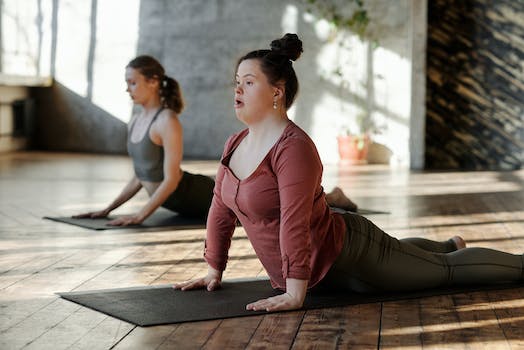-
Table of Contents
- Introduction
- The Benefits of Stretching: How to Incorporate Flexibility Training Into Your Routine
- The Power of Nutrition: How to Eat for a Healthy and Strong Body
- The Benefits of Strength Training: How to Build Muscle and Increase Strength
- The Benefits of Cardio Exercise: How to Get Your Heart Pumping and Burn Calories
- The Benefits of Mindful Movement: How to Incorporate Yoga and Pilates Into Your Routine
- Conclusion
“Start Today for a Healthier Tomorrow – Healthy Habits for a Strong and Flexible Body!”
Introduction
Having a strong and flexible body is essential for living a healthy and active lifestyle. It can help you stay fit, reduce the risk of injury, and improve your overall wellbeing. Developing healthy habits is the key to achieving and maintaining a strong and flexible body. This includes eating a balanced diet, exercising regularly, and getting enough rest. By following these simple steps, you can ensure that your body is in the best shape possible.
The Benefits of Stretching: How to Incorporate Flexibility Training Into Your Routine

Stretching is an important part of any fitness routine, yet many people overlook it. Incorporating flexibility training into your routine can help you improve your overall health and performance. Here are some of the benefits of stretching and how to incorporate it into your routine.
1. Improved Mobility and Flexibility
Stretching helps to improve your range of motion and flexibility. This can help you move more freely and reduce the risk of injury. Regular stretching can also help to reduce muscle tension and improve posture.
2. Improved Circulation
Stretching helps to increase blood flow to your muscles, which can help to reduce fatigue and improve your overall performance. It can also help to reduce muscle soreness after a workout.
3. Stress Relief
Stretching can help to reduce stress and tension in your body. It can also help to improve your mood and reduce anxiety.
4. Improved Balance
Stretching can help to improve your balance and coordination. This can help to reduce the risk of falls and other injuries.
Now that you know the benefits of stretching, here are some tips for incorporating it into your routine:
• Start with a warm-up. Before stretching, it’s important to warm up your muscles. This can help to reduce the risk of injury and make stretching more effective.
• Stretch after every workout. Stretching after a workout can help to reduce muscle soreness and improve your recovery time.
• Focus on your breathing. When stretching, it’s important to focus on your breathing. This can help to relax your muscles and make stretching more effective.
• Stretch for at least 10 minutes. Aim to stretch for at least 10 minutes each day. This can help to improve your flexibility and reduce the risk of injury.
Stretching is an important part of any fitness routine. Incorporating flexibility training into your routine can help to improve your mobility, circulation, balance, and stress levels. By following the tips above, you can make stretching a regular part of your routine and reap the benefits.
The Power of Nutrition: How to Eat for a Healthy and Strong Body
Good nutrition is essential for a healthy and strong body. Eating the right foods can help you maintain a healthy weight, reduce your risk of chronic diseases, and provide your body with the energy it needs to stay active. Here are some tips to help you make the most of your nutrition and get the most out of your meals.
1. Eat a variety of foods. Eating a variety of foods is important for good nutrition. Aim to include a variety of fruits, vegetables, whole grains, lean proteins, and healthy fats in your diet. Eating a variety of foods will help ensure that you get all the essential nutrients your body needs.
2. Choose nutrient-dense foods. Nutrient-dense foods are those that are high in vitamins, minerals, and other essential nutrients. Examples of nutrient-dense foods include fruits, vegetables, whole grains, lean proteins, and healthy fats. Eating nutrient-dense foods will help you get the most nutrition out of your meals.
3. Limit processed foods. Processed foods are often high in calories, sugar, and unhealthy fats. Eating too many processed foods can lead to weight gain and an increased risk of chronic diseases. Try to limit your intake of processed foods and focus on eating more whole, nutrient-dense foods.
4. Eat breakfast. Eating breakfast is important for good nutrition. Eating breakfast can help jumpstart your metabolism and provide your body with the energy it needs to stay active throughout the day. Aim to include a combination of protein, healthy fats, and complex carbohydrates in your breakfast.
5. Stay hydrated. Staying hydrated is essential for good health. Aim to drink at least 8 glasses of water per day. Drinking water can help keep your body hydrated and can help you feel full, which can help you eat less.
By following these tips, you can make the most of your nutrition and get the most out of your meals. Eating a variety of nutrient-dense foods, limiting processed foods, eating breakfast, and staying hydrated can help you maintain a healthy weight, reduce your risk of chronic diseases, and provide your body with the energy it needs to stay active.
The Benefits of Strength Training: How to Build Muscle and Increase Strength
Strength training is an important part of any fitness routine. It helps to build muscle, increase strength, and improve overall health. Strength training can be done with weights, machines, or bodyweight exercises. It is important to understand the benefits of strength training and how to properly perform exercises to maximize results.
Strength training can help to build muscle and increase strength. When done correctly, strength training can help to increase muscle size and strength. This can help to improve athletic performance, reduce the risk of injury, and improve overall health. Strength training can also help to improve posture, balance, and coordination.
Strength training can also help to improve bone density. As we age, our bones become weaker and more prone to fractures. Strength training can help to increase bone density, which can reduce the risk of fractures and osteoporosis.
Strength training can also help to improve cardiovascular health. Regular strength training can help to increase heart rate and improve blood flow. This can help to reduce the risk of heart disease and stroke.
When performing strength training exercises, it is important to use proper form. This will help to ensure that you are getting the most out of your workout and reducing the risk of injury. It is also important to use a weight that is challenging but not too heavy. Start with lighter weights and gradually increase the weight as you become stronger.
It is also important to give your body time to rest and recover between workouts. This will help to ensure that your muscles have time to repair and rebuild. Aim for at least 48 hours of rest between strength training sessions.
Strength training can be a great way to build muscle, increase strength, and improve overall health. It is important to understand the benefits of strength training and how to properly perform exercises to maximize results. With proper form and rest, you can get the most out of your strength training routine.
The Benefits of Cardio Exercise: How to Get Your Heart Pumping and Burn Calories
Cardio exercise is an important part of any fitness routine. It helps to strengthen your heart and lungs, burn calories, and improve your overall health. But how do you get your heart pumping and burn calories? Here are some tips to help you get the most out of your cardio workouts.
1. Increase the Intensity: To get your heart rate up and burn more calories, you need to increase the intensity of your workout. This can be done by increasing the speed or incline of your workout, or by adding intervals of high-intensity exercise.
2. Choose the Right Exercise: Different types of cardio exercise have different benefits. For example, running is great for burning calories, while swimming is better for building endurance. Choose the type of exercise that best suits your goals.
3. Warm Up and Cool Down: Before and after your workout, it’s important to warm up and cool down. This helps to prevent injury and prepare your body for the workout.
4. Monitor Your Progress: To stay motivated and track your progress, use a heart rate monitor or fitness tracker. This will help you to see how your workouts are improving your fitness level.
By following these tips, you can get your heart pumping and burn calories with cardio exercise. With regular exercise, you’ll be on your way to a healthier, fitter you!
The Benefits of Mindful Movement: How to Incorporate Yoga and Pilates Into Your Routine
Are you looking for a way to improve your physical and mental health? Incorporating mindful movement into your daily routine can be a great way to do just that. Mindful movement is any type of exercise that focuses on the connection between the body and the mind. This includes activities such as yoga and Pilates.
Yoga is an ancient practice that combines physical postures, breathing exercises, and meditation. It is designed to help you become more aware of your body and your breath. Practicing yoga can help you become more mindful of your body and its movements, as well as help you to relax and reduce stress.
Pilates is a form of exercise that focuses on strengthening the core muscles and improving posture. It is designed to help you become more aware of your body and its movements. Practicing Pilates can help you become more mindful of your body and its movements, as well as help you to improve your balance and coordination.
Incorporating mindful movement into your daily routine can have many benefits. It can help you become more aware of your body and its movements, as well as help you to relax and reduce stress. It can also help you to improve your balance and coordination, as well as strengthen your core muscles and improve your posture.
If you’re looking to incorporate mindful movement into your daily routine, there are a few things you can do. First, find a yoga or Pilates class that fits your schedule and interests. You can also practice yoga or Pilates at home by following along with online videos or using an app. Finally, make sure to set aside time each day to practice mindful movement.
Incorporating mindful movement into your daily routine can be a great way to improve your physical and mental health. Whether you choose to practice yoga or Pilates, make sure to set aside time each day to focus on your body and its movements. With regular practice, you’ll soon be reaping the many benefits of mindful movement.
Conclusion
In conclusion, healthy habits are essential for a strong and flexible body. Eating a balanced diet, exercising regularly, and getting enough sleep are all important components of a healthy lifestyle. Additionally, stretching and foam rolling can help to improve flexibility and reduce the risk of injury. By following these tips, you can maintain a strong and flexible body for years to come.















